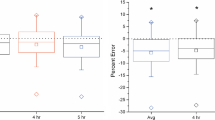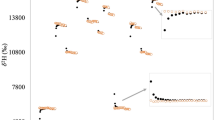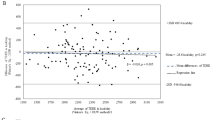Abstract
Background:
The doubly labelled water (DLW) method is the technique of choice for measurement of free-living total energy expenditure (TEE) in humans. A major constraint on the clinical applicability of the method has been the expense of the 18O isotope.
Method:
We have used a reduced-dose (one-tenth of the currently recommended standard dose) of DLW for the measurement of TEE and body composition in nine healthy adult male volunteers.
Results:
TEE measured by reduced-dose DLW was positively correlated with resting energy expenditure measured by metabolic cart (r=0.87, P<0.01). Isotope-derived fat mass and body mass index were strongly correlated (r=0.86, P<0.01). In four subjects in whom we performed a complementary evaluation using standard-dose isotope enrichment, the TEE measurements were satisfactorily comparable (mean±s.d.: reduced dose 2586±155 kcal/day vs standard dose 2843±321 kcal/day; mean difference 257±265 kcal/day).
Conclusion:
These data indicate that DLW measurements of human energy expenditure and body composition can be performed at a substantially reduced dose (and cost) of isotope enrichment than is currently employed.
This is a preview of subscription content, access via your institution
Access options
Subscribe to this journal
Receive 12 print issues and online access
$259.00 per year
only $21.58 per issue
Buy this article
- Purchase on Springer Link
- Instant access to full article PDF
Prices may be subject to local taxes which are calculated during checkout



Similar content being viewed by others
References
Black A, Coward W, Cole T, Prentice A . Human energy expenditure in affluent societies: an analysis of 574 doubly-labelled water measurements. Eur J Clin Nutr 1996; 50: 72–92.
Speakman J . Doubly Labelled Water – Theory and Practice. London: Chapman and Hall, 1997.
Schoeller D . Energy expenditure from doubly labelled water: some fundamental considerations in humans. Am J Clin Nutr 1983; 38: 999–1005.
Thielecke F, Noack R . Evaluation of an automated equilibration technique for deuterium/hydrogen isotope ratio measurements with respect to assessing total energy expenditure by the doubly labelled water method. J Mass Spectrom 1997; 32: 323–327.
Schoeller D, Ravussin E, Schutz Y, Acheson K, Baertschi P, Jequier E . Energy expenditure by doubly labelled water: validation in humans and proposed calculation. Am J Physiol 1986; 250: R823–R830.
DeWeir J . New methods for calculating metabolic rate with special reference to protein metabolism. J Physiol 1949; 109: 1–9.
Prentice T, Siri W, Berlin N, Hyde G, Parsons R, Joiner E et al. Studies of total body water with tritium. J Clin Invest 1952; 31: 412–418.
Schoeller D, Hnilicka J . Reliability of the doubly labelled water method for the measurement of total daily energy expenditure in free-living subjects. J Nutr 1996; 126: 348S–354S.
Ravussin E, Burnand B, Schutz Y, Jequier E . Twenty-four-hour energy expenditure and resting metabolic rate in obese, moderately obese, and control subjects. Am J Clin Nutr 1982; 35: 566–573.
Carpenter W, Poehlman E, O'connell M, Goran M . Influence of body composition and resting metabolic rate on variation in total energy expenditure: a meta-analysis. Am J Clin Nutr 1995; 61: 4–10.
Westerterp K . Obesity and physical activity. Int J Obesity 1999; 23 (Suppl 1): 59–64.
Roberts S . Abnormalities of energy expenditure and the development of obesity. Obesity Res 1995; 3 (Suppl 2): 155s–163s.
Horvitz M, Schoeller D . Natural abundance deuterium and 18-oxygen effects on the precision of the doubly labelled water method. Am J Physiol 2001; 280: E965–E972.
Author information
Authors and Affiliations
Corresponding author
Rights and permissions
About this article
Cite this article
Mann, D., Ho, C., Critchley, L. et al. Affordable measurement of human total energy expenditure and body composition using one-tenth dose doubly labelled water. Int J Obes 31, 751–755 (2007). https://doi.org/10.1038/sj.ijo.0803507
Received:
Revised:
Accepted:
Published:
Issue Date:
DOI: https://doi.org/10.1038/sj.ijo.0803507



